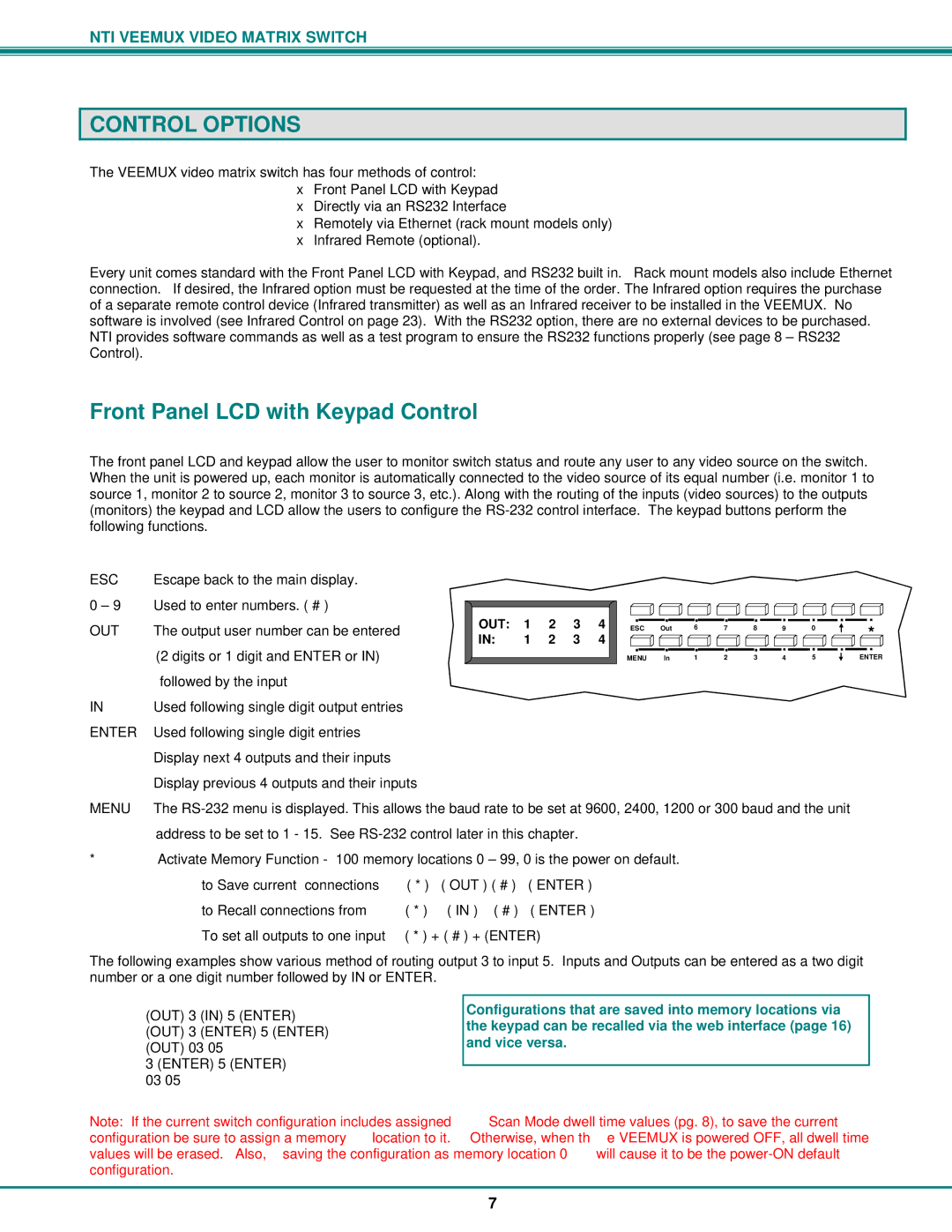
NTI VEEMUX VIDEO MATRIX SWITCH
CONTROL OPTIONS
The VEEMUX video matrix switch has four methods of control:
•Front Panel LCD with Keypad
•Directly via an RS232 Interface
•Remotely via Ethernet (rack mount models only)
•Infrared Remote (optional).
Every unit comes standard with the Front Panel LCD with Keypad, and RS232 built in. Rack mount models also include Ethernet connection. If desired, the Infrared option must be requested at the time of the order. The Infrared option requires the purchase of a separate remote control device (Infrared transmitter) as well as an Infrared receiver to be installed in the VEEMUX. No software is involved (see Infrared Control on page 23). With the RS232 option, there are no external devices to be purchased. NTI provides software commands as well as a test program to ensure the RS232 functions properly (see page 8 – RS232 Control).
Front Panel LCD with Keypad Control
The front panel LCD and keypad allow the user to monitor switch status and route any user to any video source on the switch. When the unit is powered up, each monitor is automatically connected to the video source of its equal number (i.e. monitor 1 to source 1, monitor 2 to source 2, monitor 3 to source 3, etc.). Along with the routing of the inputs (video sources) to the outputs (monitors) the keypad and LCD allow the users to configure the
ESC | Escape back to the main display. |
|
|
|
|
|
|
|
|
|
|
|
|
|
|
|
|
|
|
|
|
|
|
|
|
|
|
0 – 9 | Used to enter numbers. ( # ) | OUT: | 1 | 2 | 3 | 4 |
|
|
|
|
|
|
|
|
|
|
|
|
|
|
|
|
|
|
|
|
|
|
|
|
|
|
|
|
|
|
|
|
|
|
|
|
|
|
|
|
|
| |||||||
OUT | The output user number can be entered |
|
|
|
|
|
|
|
|
|
|
|
|
|
|
|
|
|
|
|
|
| |||||
ESC Out 6 | 7 | 8 | 9 |
| 0 |
|
|
|
|
|
|
| |||||||||||||||
|
|
|
|
|
|
|
| ||||||||||||||||||||
IN: | 1 | 2 | 3 | 4 |
|
|
|
|
|
|
|
|
|
|
|
|
|
|
|
|
|
|
|
|
| ||
|
|
|
|
|
|
|
|
|
|
|
|
|
|
|
|
|
|
|
|
|
|
| |||||
*
| (2 digits or 1 digit and ENTER or IN) |
|
|
|
|
|
|
|
|
|
|
|
|
|
|
|
|
|
|
|
|
| MENU In | 1 | 2 | 3 | 4 | 5 |
|
|
|
| ENTER | ||||||||||
|
|
| |||||||||||||||||||
|
|
| |||||||||||||||||||
| followed by the input |
|
|
|
|
|
|
|
|
|
|
|
|
|
|
|
|
|
|
|
|
IN | Used following single digit output entries |
|
|
|
|
|
|
|
|
|
|
|
|
|
|
|
|
|
|
|
|
ENTER | Used following single digit entries |
|
|
|
|
|
|
|
|
|
|
|
|
|
|
|
|
|
|
|
|
| Display next 4 outputs and their inputs |
|
|
|
|
|
|
|
|
|
|
|
|
|
|
|
|
|
|
|
|
| Display previous 4 outputs and their inputs |
|
|
|
|
|
|
|
|
|
|
|
|
|
|
|
|
|
|
|
|
MENU | The |
|
| ||||||||||||||||||
address to be set to 1 - 15. See
*Activate Memory Function - 100 memory locations 0 – 99, 0 is the power on default.
to Save current connections | ( * ) | ( OUT ) ( # ) ( ENTER ) |
to Recall connections from | ( * ) | ( IN ) ( # ) ( ENTER ) |
To set all outputs to one input | ( * ) + ( # ) + (ENTER) | |
The following examples show various method of routing output 3 to input 5. Inputs and Outputs can be entered as a two digit number or a one digit number followed by IN or ENTER.
(OUT) 3 (IN) 5 (ENTER)
(OUT) 3 (ENTER) 5 (ENTER)
(OUT) 03 05
3 (ENTER) 5 (ENTER)
03 05
Configurations that are saved into memory locations via the keypad can be recalled via the web interface (page 16) and vice versa.
Note: If the current switch configuration includes assigned Scan Mode dwell time values (pg. 8), to save the current configuration be sure to assign a memory location to it. Otherwise, when the VEEMUX is powered OFF, all dwell time values will be erased. Also, saving the configuration as memory location 0 will cause it to be the
7
